최고 권위의 모터 스포츠인 Formula 1의 명문팀 McLaren
Mercedes와 정밀공학의 선두주자 TAG HEUER사에서 합작 오디오 제작사인 TAG McLaren 사는 스포츠카의 핵심 기술인
물리학과 전자제어, 기계공학,항공 기술등의 보유 기술을 바탕으로 최고의 음향 영상 기술을 이루어 내었습니다. 제품의 역동적인 디자인은
설치장소에 귀족적인 우아함을 선사해 주며, 정적인 공간에 활기찬 생명력을 줍니다. TAGMcLaren제품들은 TAGtronic comunication
Bus를 통해 상호 정보를 교환합니다. 간단하게는 On/Off 기능에서부터 DVDP와 Processor간에 발생하는 지터를 감쇄하며,
화면과 음향의 LipSync를 완벽하게 일치 시키는 놀라운 연동성을 가지고 있습니다. 빠르게 변하는 최신의 디지탈 포맷들은 인터넷을
통해 지속적으로 업그레이드 할 수 있습니다. TAGMcLaren 오디오의 우수한 밸런스의 음향과 풍요로운 영상미를 통해 즐거운 여가
생활을 즐겨 보시기 바랍니다.
진동에 강한 매카니즘을 사용하여 필요치 않은 진동의 악영향을 제거 하였습니다. 메인 섀시와 분리된 구동계의 프레임 무게만도 8Kg에
달하여 외부의 어떠한 진동에도 영향을 최소화 하였습니다.
풍부한 색감과 밝고 어두움의 완벽한 조화로 인한 다이나믹한 영상미는 귀하를 행복하게 할 것입니다. 프로그래시브 스캔 모듈을 통해
더욱 섬세한 영상을 즐기실 수 있는 하이엔드 DVDP입니다. 또한 DVD-Audio나 SACD 등의 음악포맷을 지원을 위해 IEEE1394
인터페이스 장착을 위한 여유 공간이 마련되어 있습니다.
 주요
특징 주요
특징
-NTSC와 PAL방식에 모두 대응 가능
-레퍼런스급의 CD재생
-육중한 서브 샤시로 인한 지터 감소및 데이터 처리의 고효율화
-Pantera-DVD칩 사용
-TAGMcLaren의 AV프로세서와 T2L회로를 통해 지터를 최소화
-제품내의 모든 전원 공급부에 독립 전원부 채용
DVD32R 은 톱 로딩 방식으로 제작되었으며 육중한 섀시와 차가운 금속적인 질감을 도트 매트릭스 방식의 대형 디스플레이에 조합함으로서
디스플레이의 윤곽이나 버튼의 배열에서 느껴지는 세련미는 기존의 오디오 제품과는 격을 달리할 정도입니다. 아름다운 곡선미를 자랑하는
탑 패널은 왼쪽으로 미끄러지듯이 이동하면서 열리는데 내부를 은은히 조명해 주는 푸른색의 LED 는 환상적인 분위기를 연출해 줍니다.
DVD32R 의 영상 처리부에는 미디어 매틱스의 팬테라칩을 사용했는데, 이는 최근 업계에서 문제 되고 있는 크로마 버그가 발생하지
않는 우수한 칩셋으로 알려져 있습니다. 또 다른 중요한 특징은 차후의 업그레이드에 대한 철저한 대비를 들 수 있습니다. 최고급 부품
구성으로, 강력한 업그레이드 제공합니다. 또한 DVD32R은 THX? Ultra 가 요구 하는 모든 조건을 완벽하게 부합하고 있다.
 최상의
소리 최상의
소리
DVD32R은 탑로딩 방식으로 드라이브 벨트 방식을 사용하고 있다. 극도로 노이즈를 억제하고 있다. 아날로그 회로부는 안전성 높은
비세의 저항을 비롯해 최고품의 부품을 사용하였으며, 진동을 억제하기
위한 라미네이트 구조의 새시나 소보탄 재질의 받침을 사용. 또한 지터를 최소한하는 T2L 링크까지 마련되어 있는 제품입니다.
 최상의
화면 최상의
화면
TAG McLaren의 MPEG 디코더분야는 Mediamatics의 자회사인 내셔널반도체분야와의 작품으로 오랜 평가 끝에 single
chip이 있는 DVD player의 모든 back-end기능을 통합한 최초의 IC인 Pantera-DVD™ 이 선택되었습니다.
이는 최근 업계에서 문제시되고 있는 크로마 버그가 방생하지 않는 칩입니다. 이와 같은 조화로서 host processing,
32-bit RISC processor, 10-bit video DACs, NTSC/PAL encoders 등을 지원합니다.
비디오 회로도는 broadcast quality components를 사용하며, 최상의 화질을 위해 독립적인 버퍼를 가지는
비디오 아웃풋과 버티컬, anti-flicker filtering을 가집니다. in-built test-patterns과 전기기술
회로도테스트 는 최상의 화면을 재생하여 줍니다.
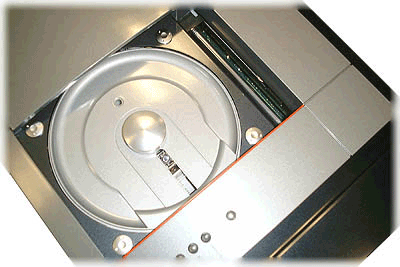
The principle
The topology and devices used to achieve the excellent sound and picture
quality of the DVD32R were selected after constructing and evaluating many
prototypes. Each prototype under went extensive laboratory, listening and
viewing tests to fine tune and compare the options. The final characteristics
were optimised by cross-referencing with experience built up over endless
hours of testing TAG McLaren's audio products.
High-mass Transport for Low Jitter
The DVD32R is one of the very few DVD players in the world to use a top
loading transport. This approach has been associated for many years with
the very best CD players. It allows a more stable platform for the laser
assembly which eases the demands on the servo control electronics and their
power supplies which in turn improves data integrity and reduces jitter.
These lessons learnt apply even more to the higher density, very fast spinning
DVD.
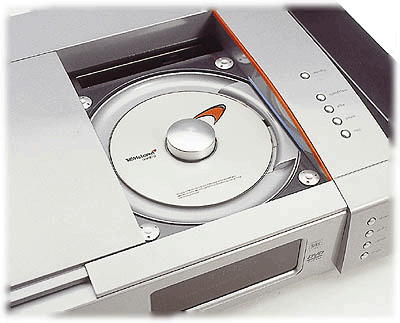
The DVD32R's drive motor and servo electronics are mounted to a purpose
built aluminium sub-chassis, which has been mass loaded by carefully placed
lead. The resulting assembly weighs almost 1 kg, and is supported on carefully
selected damping isolation bushes for further mechanical decoupling. The
entire drive assembly is in a sub-enclosure for electrical screening which
in turn is rigidly fixed to a solid 3 mm aluminium plate. A servo control
and data recovery printed circuit board (which receives its clock from the
main pcb via a dedicated coaxial link) is attached to the sub-enclosure
as close as possible to the dual wavelength laser assembly, screened by
a metal plate. The data is serialised and sent to the MPEG decoder on the
main pcb. Automatic, Adaptive
Drawer Mechanism
Many hi-end top-loading constructions have manual open/close operation
which seems incompatible and inconvenient with a high cost product. The
DVD32R aluminium diecast drawer door runs on a polished steel bar and
a Teflon glider, driven by an electric motor via a steel wire. The torque
of the motor is progressively adapted by the control software to achieve
perfect and consistent performance over temperature and age.
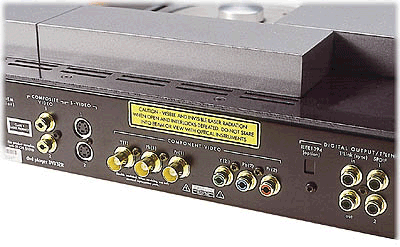
Convenient Disc Changing in the Dark
When the drawer opens it activates an array of blue LEDs inside the drawer
to assist placing a disc which is beneficial in a home cinema environment.
The light is switched off during play to prevent potential interference.
Precise Clock for best Sound
and Video Quality
Accurate extraction of the disc's audio and video data demands precise
clocks. The low phase noise single frequency master oscillator in the
DVD32R ensures that all video and audio clocks are synchronous to avoid
the undesired effects of 'beating'. All required clock frequencies are
derived from this master clock using a phase locked loop and two voltage
controlled oscillators. The clock signals are transferred across the PCB
using independently buffered and precisely terminated clock traces to
each of the circuits. This prevents decision threshold uncertainty which
would introduce jitter. The result is purer sound and a more precise picture.
The MPEG Decoder from the Experts
MPEG decoding is at the core of a DVD player. TAG McLaren Audio worked
closely with National Semiconductor's field-leading subsidiary Mediamatics,
in finding the best MPEG decoder solution. After long evaluation Pantera-DVD™,
the first IC to integrate all back-end functions of a DVD player onto
a single chip, was selected. This unrivalled level of integration, which
includes host processing, a 32-bit RISC processor, MPEG specific hardware,
10-bit video DACs and the NTSC and PAL encoders, provides the DVD32R with
a no-compromise MPEG decoder solution.
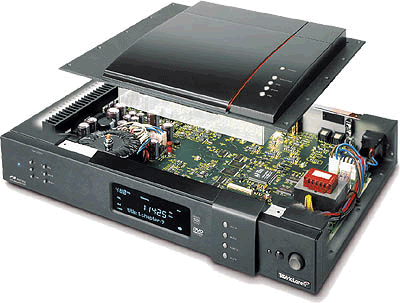
Uncompromised Video quality
The video circuitry within the DVD32R uses broadcast quality components
along its entire signal paths. The video outputs are individually buffered
by high speed current-feedback op-amps. Besides two Composite and two
S Video outputs, two sets of Component video outputs are provided, one
using RCA Phono, the other broadcast quality BNC connectors. For best
Component video quality S Video and Composite are switched off, except
when an on-screen graphic is presented by the software.
Crisp On-screen Display (OSD)
The video processing elements include vertical filtering and an anti-flicker
filter to also deliver high quality graphics display. The full-resolution
on-screen display is produced by an integrated digital domain OSD generator,
avoiding any superfluous circuitry in the analog video paths. The result
is uncompromised picture quality.
Test-Pattern generator
The picture from the DVD32R can only be as good as your display device
allows. The DVD32R includes software-driven test-patterns and hardware
test circuitry to assist in calibrating the display device for best brightness,
contrast, colour, tint, sharpness, convergence and geometry setting.
Advanced Digital Waveform Control for
Better Digital Data Transmission
One would expect that a perfect digital signal is a so called square wave
with very fast rise and fall times at the zero crossing points, but this
would require digital interconnects with an infinite bandwidth and would
make it impossible to prevent signal reflections and interference, degrading
the quality of the digital signal and hence the sound. It is important
to keep the signal bandwidth to a minimum, whilst maintaining accurate
transitions of the data edges through the zero crossing point. The DVD32R
incorporates advanced circuitry which reduces rise and fall times whilst
preventing waveform discontinuities, the result is a reduced bandwidth
and less demand on the digital interconnects.

Discrete, independent Digital Audio Drivers for perfect decoupling
The DVD32R uses, for added sonic perfection, two separate, discrete drivers,
tightly controlled in their output impedance to 75 ohms, for each of its
two coaxial digital audio data outputs. This not only ensures complete
isolation between the outputs but also that any reflections occurring
at the receiving end, due to an impedance mismatch, are not re-reflected
back from the DVD32R.
TAGtronic Synchronisation Link T2L
for Reduced Jitter
When the DVD32R and AV32R are used together, the TAGtronic Synch. Link
T2L produces a tighter, cleaner and more controlled sound. T2L allows
the AV32R to fix its clock to provide a low noise, ultra low jitter reference
right next to its audio DACs, where it needs to be for optimum sound quality.
Locking the AV32R's clock requires the DVD32R to synchronise its clocks
to the AV32R, which is done through the TAGtronic Synch. Link. The DVD32R
provides both a T2L input and output connection to permit easy daisy-chaining
of further digital sources with T2L capability, such as the TAG McLaren
CD transport CDT20R.
Massive Power Reserves
Despite its low power consumption the DVD32R uses a large toroidal transformer
as this has the benefit of a very low stray magnetic field, reducing the
possibility of interference with the audio data and video signals. The
transformer is also very quiet, reducing hum to an inaudible level.
Convenience without Penalty: Low Standby
Power
The DVD32R includes a second, smaller transformer to power the remote
control and micro-controller circuitry. This results in very low electrical
consumption (<3W) when the DVD32R is switched to standby whilst allowing
full remote control.
Best Decoupling between Building Blocks
To reduce interference between the processing, digital data and analog
video sections they have separate power supplies, right down to having
eight separate secondary windings on the transformer.

Multi-Layer Printed Circuit Boards for Improved Signal Integrity
The DVD32R's multi-layer printed circuit boards control the complex pattern
of return currents, provide controlled impedances and minimise coupling
better than a conventional circuit board could ever do. The result is
better signal to noise, reflected in crisper pictures and sound.
Mixed Technology Construction-the Best
of both Worlds
Performance is optimised using surface mount components for fast digital
transfer and leaded components for perfect analog signals whilst perfect
manufacturing quality is achieved using a combination of inert-gas reflow
and wave soldering techniques.
The TAGtronic Communication Bus for
System Integration
The DVD32R features the TAGtronic Communication Bus. This allows TAG McLaren
Audio units to work seamlessly together to form an effective, integrated
system. Remote control codes can be transferred over the bus, allowing
system components to be operated out of sight. The DVD32R can even switch
your complete TAG McLaren home cinema system into standby.
Multi-room Expansion
The TAGtronic Bus will allow the system to be extended to offer multi-room
capability in which the output from sources can be controlled and redirected
throughout a home.

TAG McLaren has successfully demonstrated that upgradability is a reality.
The DVD32R follows this tradition:
New Features
All of the DVD32R software is kept in re-programmable, FLASH memory. This
is a significant advantage over players which, for cost reasons, cannot
offer field re-programmability. Software upgrades allow the DVD32R to
support new features and formats, all that is required is to download
upgrades from the TAG McLaren Audio website using a PC and a TAGtronic
Programming cable. DVD-Audio
TAG McLaren is continuously observing the market to look for abilities
to improve their products. One of the most promising new formats is DVD-Audio.
TAG McLaren is working, in close relationship with Mediamatics, on the
hardware and software implementation of this fascinating new format. The
DVD32R is upgradable to DVD-Audio as soon as this standard is fully specified.
The transport is already capable to read DVD-Audio discs but no hardware
or software processing has been added to the DVD32R due to many unspecified
features of the standard (copy protection, high quality digital output
format).
Progressive Scan Video
The DVD32R hardware can be upgraded to progressive scan for NTSC and PAL.
Digital Video Output
Pending copy protection issues and international standardisation, the
DVD32R is hardware upgradable to a digital video output. A suitable TV/projector
will be necessary to accept and process this new digital signal.
업그래이드 경로
DVD32R은 업그래이드가 가능하며, Progressive Scan, Digital Video 등의 하드웨어 업그래이드를 받을
수 있도록 짜여져 있으며, 기능적인 향상은 TAG McLaren's의 웹사이트를 통하여 업그래이드 가능합니다. 또한 집에서 PC를
사용하여 쉽고 간편하게 소프트웨어를 업그래이드 받을 수도 있습니다. 또한 DVD-Audio나 SACD 등의 차세대 음악포맷을
지원을 위한 IEEE1394 인터페이스 장착을 위한 여유공간 마련되어 있다.
DVD32R 옵션
The Progressive Scan Module PSM192
+ DVI
테그맥라렌의 하인엔드 프로그레시브 모듈
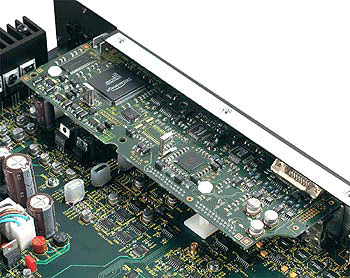 |
The PSM192 de-interlaces all your video
sources! ...why only enhance DVDs?
Progressive Scan or De-interlacing, i.e. the generation of a picture
which is progressively scanned every 1/50s (NTSC: 1/60) from top
to bottom, has recently become popular in the context of the latest
DVD player technology.
Progressive Scan provides significant picture enhancement, but
should not be limited to DVD. Why not use a general purpose Progressive
Scan Module, like the PSM192, instead, to de-interlace all your
video sources? TV, VCR, Laserdisc, video camera, satellite receiver
etc. will all improve, just like your DVD!
Interlacing, i.e. splitting a picture into two fields of half the
line count, which in PAL transmissions are sent 1/50 (NTSC: 1/60)
seconds apart, leads to reduced vertical picture resolution and
flicker. Unfortunately, just 'gluing’ those fields together afterwards
isn't that simple.
|
Progressive Scan results in better
vertical picture resolution, reduced motion artefacts and reduced
flicker, making us wonder how we could ever have lived without it.
Two of the very latest Plasma screens from different
manufacturers were therefore pulled into our laboratory for analysis.
The tests were: firstly feed the screens with ‘standard’ interlaced
video, therefore using the Plasmas' internal Progressive Scan modules
and scalers, secondly feed the screens from the output of the PSM192,
installed in a DVD32R.
Before undertaking this experiment we were sceptical about the outcome,
thinking that Plasma technology should have
progressed nicely, leaving very little else to offer. However, comparing
the picture quality of these two 42" Plasmas left me surprised:
the pictures couldn't be more different, whether interlaced or de-interlaced.
Feeding the very same signal resulted in significantly different pictures,
proving that video technology surely hasn’t reached ‘Picture Perfect’
yet.
Acknowledging the fact that the picture quality differences between
Plasmas of different manufacturers are still huge, we focussed on
the performance of the Plasmas’ internal de-interlacer compared to
the PSM192 installed in the DVD32R. It wasn’t difficult to see the
differences, Silicon Image’s latest technology in the PSM192 showed
clear gains, resulting in a picture which was crisper, showing sharper
details and reduced motion artefacts.
Should
this really surprise us? Display technologies are expensive, savings
on ultimate picture quality versus screen size are all important
and if you haven’t seen what is possible, you might not even know
what you are missing. In a very competitive market, such as display
technology, adding a six layer, highly integrated and powerful Progressive
Scan Module, such as the PSM192, is commercially just not viable
- not for the display manufacturer!
If you have a DVD32R or DVD32FLR, of
whatever specification, then you can have it upgraded with the Progressive
Scan Module PSM192, improving picture quality of DVDs and all your
Composite and S-Video sources.
The upgrade requires the DVD32R / DVD32FLR
to come back to us, as we will update the chassis and rewire the
DVD32R's multi-layer printed circuit board before installing the
six-layer PSM192 board. All this requires special tools and skills!
The upgrade will take about two working
weeks, not counting shipping times, and is covered by your standard
DVD32R / DVD32FLR’s product warranty.
|
| |
|
| [제품사양] |
|
| technical specifications |
| |
|